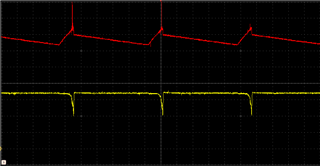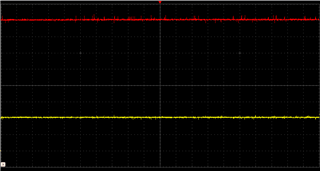Other Parts Discussed in Thread: BQ24650
Tool/software:


These images are from a LM5123-Q1 boost converter set to 16V target which then feeds a buck converter/battery charger. The left image is what happens if no resistor is placed in series with the AGM battery. The right image has a 2R resistor placed in series with the battery positive terminal. The lower trace (yellow) is the input via a short length of lead. The upper trace (red) is the boost output.
Also, if the input voltage is increased to force the LM5123-Q1 into bypass, the input voltage can then be decreased and the continuous restarts no longer occur. If the input voltage is taken still lower until the LM5123-Q1 stops and then increased to a low voltage for restart, the continuous restarts begin again.
It is important we find an answer to this because the boost converter will be connected to solar cells 24Hrs a day.

